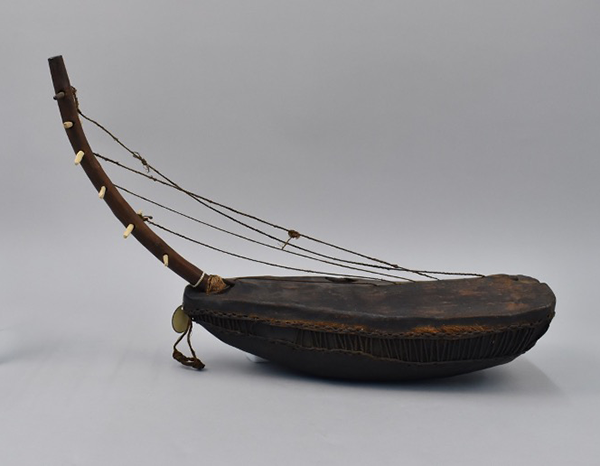Cultural Restitution
SHARE ARTICLE
The University of Cambridge Museum of Archaeology and Anthropology (MAA) became one of the first museums in the UK to return artefacts to a source country when it returned a group of sacred relics to Uganda in 1961.
The relics were associated with Kibuuka, a deity in the religion of the Baganda people that reside in present-day Uganda. After the Ugandan government requested their repatriation, the relics were transferred to the Uganda Museum in Kampala, the oldest museum in East Africa.
Since then, relations between the MMA and Uganda have remained strong, although Professor Nicholas Thomas, Director of the MMA, has acknowledged the Museum was slow to follow up on this important 1961 initiative. But relations were re-energised in 2021 when a project called ‘Repositioning the Uganda Museum’ was launched on the back of a grant of $100,000 from the arts and humanities organisation The Andrew W. Mellon Foundation.
With University of Michigan Professor Derek Peterson serving as principal investigator, the project has become an important step in undoing the legacy of collecting during Uganda’s colonial era, allowing for a renewed academic dialogue and the return of items of exceptional significance. Professor Thomas hopes this carefully conceived programme may also provide a model for similar initiatives elsewhere in Africa, “and indeed elsewhere in the world.”
The process for researching and selecting objects from Cambridge collections began in 2022 and included a visit to the MAA in November by Uganda’s Commissioner for Monuments and Museums, Rose Mwanja Nkaale, Uganda Museum’s Curator, Nelson Abiti, and Professor Peterson.
“We want to put these objects back into the hands of people who made them meaningful,” said Peterson. “We want them to live again, not only as museum pieces but as part of Uganda’s public culture.”
The objects were acquired by British colonial administrators, missionaries, anthropologists and soldiers in a variety of ways during the 1890s and early 1900s, including confiscation, theft, gift and purchase. Several items were donated to the Museum by Apolo Kaggwa, Katikiro (Prime Minister) of the Kingdom of Buganda. Other donors include British colonial officials Sir Harry Hamilton Johnston, Ernest Balfour Haddon, Frank Rogers, John Gilbert Rubie and the Anglian Missionary Arthur Bryan Fisher. However, most of the items likely to be transferred were collected and donated to the MAA by Rev. John Roscoe (1861-1932), an Anglican missionary who spent twenty-five years travelling in East Africa conducting anthropological research, partly under the direction of the MAA. Highlights of the objects he subsequently donated to the Museum, but not kept on exhibition, include a Bugandan royal drum and a musical instrument.

Musical Instrument. Bagesu people. Courtesy of Cambridge Museum of Archaeology and Anthropology
The MAA says it is fully aware of the significance of the Roscoe collection as well as other material to the Uganda Museum and fully support this repatriation initiative. Meanwhile, explaining the significance of this grant, the first of its kind towards restitution, commissioner Rose Mwanja Nkaale said: “Bringing these items back - and attracting those from around the diaspora to see them on the continent - will also help people come to terms with their own collective memory, celebrate their rich histories and identities, and be able to pass this on to future generations.”
The transfer of ownership of the selected objects and their repatriation for community liaison, study and exhibition at the Uganda Museum is scheduled for completion in 2023.
After this was written...
The team from MAA with 39 artefacts chosen by colleagues from the Uganda Museum finally arrived at Entebbe airport on Saturday 8 June 2024. The artefacts were those selected during the research visit made to Cambridge in November 2022 and were chosen to represent the heritage, history and beliefs of diverse Kingdoms and communities in Uganda, including Acholi, Ankole, Baganda, Bahima, Bakedi, Banyoro and Teso.
The artefacts selected include a Lubaale vessel from Buganda (acquired 1907), decorated pots from Ankole (acquired in the 1920s) and a headdress made of human hair from Lango (acquired 1937).
According to a spokesperson from the MAA, the artefacts returning "are part of a long-term loan to the Uganda Museum to support a programme of research into the history and significance of the artefacts. This in turn will help to inform any decisions about their future care and interpretation." The loan is for an initial three-year period, meaning all the items will remain part of the MAA collection. However, we understand the loan is renewable and may lead to a permanent transfer of ownership.
The MAA has also expressed its pride "working with our partners in the country to explore their provenance and reconnect them with the Ugandan people." Curators in Cambridge expect to continue to visit Uganda to support the development of their research programme and to assist with a major exhibition of the artefacts in 2025.
The President of Uganda, Yoweri Museveni, was on hand to receive the returning artefacts. Other Ugandan officials have expressed their hope this repatriation will encourage other museums to appreciate the value of returning artefacts from Uganda in their collections. Uganda is especially keen to repatriate the unique terracotta head of woman or man, known as the Luzira head, a sculpture possibly from Baganda, thought to be 1,000 years old and discovered in 1929 on the outskirts of Kampala. It was acquired by the British Museum in 1931.
Photo: Uganda Museum, Kampala
Courtesy of Wikimedia Commons
More News



